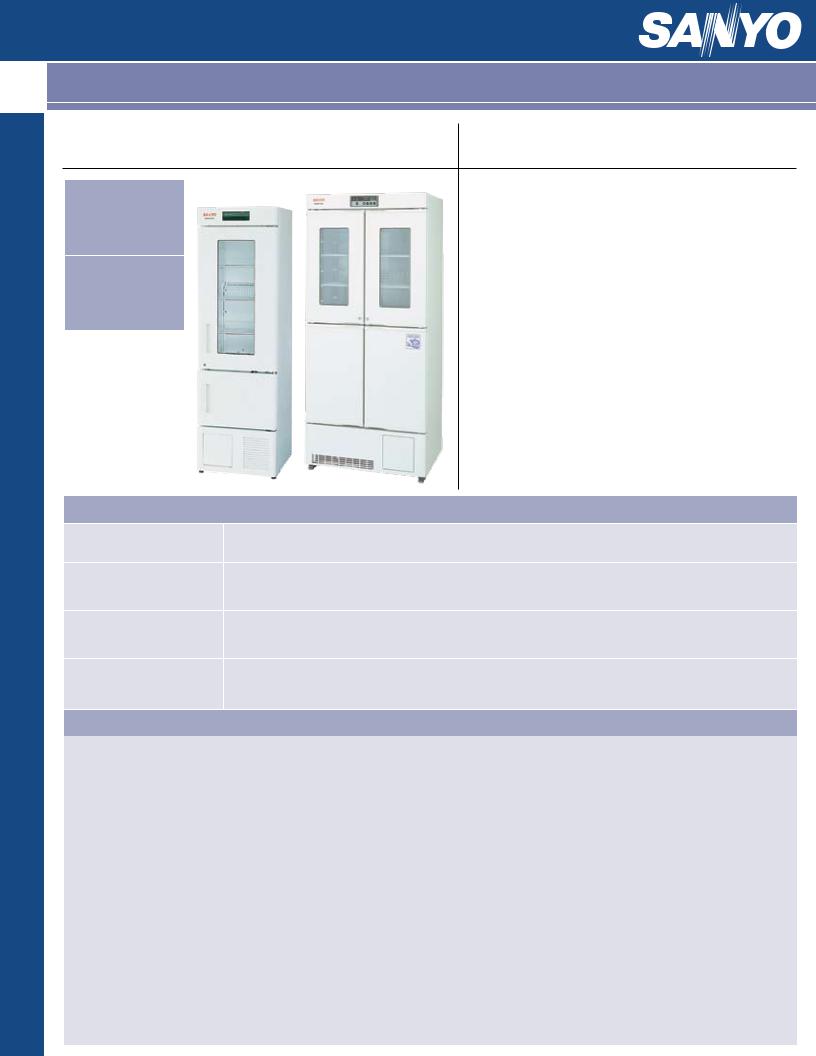Sanyo MPR-414F, MPR-214F Manual

 Pharmaceutical Refrigerator with Freezer
Pharmaceutical Refrigerator with Freezer
n o i t a v r e s e r p
MPR-214F
(R) 6.2 cu. ft.
(F) 1.4 cu ft.
MPR-414F (R)12.0 cu. ft
(F) 2.9 cu. ft.
VALIDATED STORAGE OF REAGENTS, PHARMACEUTICALS AND BIOLOGICAL SAMPLES
 Ideal biologic storage environment for precise control and superior temperature and uniformity
Ideal biologic storage environment for precise control and superior temperature and uniformity
 Microprocessor controller and interior forced air circulation
Microprocessor controller and interior forced air circulation
 Safe and secured storage behind a keyed locking door
Safe and secured storage behind a keyed locking door
 Integrated alarm functions, remote alarm contacts, and monitoring
Integrated alarm functions, remote alarm contacts, and monitoring
feature |
BENEFIT |
Microprocessor Controls |
The Microprocessor control system provides accurate temperature control |
Air Circulation |
Fan-forced air circulation system (refrigerator) offers fast recovery of temperature and better |
|
uniformity. |
Cycle Defrost System |
Unique cycle defrost system in the refrigerator prevents temperature rise by shorter defrost cycles |
|
activated after each compressor cycle. |
Alarms |
Various safety systems such as high/low temperature audible and visual alarms, remote alarm, door |
|
ajar alarm and keyed door locks. |
Technology |
|
 Dual Temperature Zone
Dual Temperature Zone  Superior Cooling Performance
Superior Cooling Performance  Triple (414F) & Double (214F) Pane Windows
Triple (414F) & Double (214F) Pane Windows
 Alarm and Safety Devices
Alarm and Safety Devices  Quiet Operation
Quiet Operation
With the growing emphasis on proper storage of laboratory and pharmacy materials, SANYO MPR Series pharmacy refrigerators with freezer combine high performance refrigeration, control and alarm/monitoring systems with energy efficient, cost-effective cabinet design. One unit with dual temperature zone needs only minimal installation space. The four door design reduces air loss during door openings. The triple or double-pane windows with heat reflection film reduces the condensation. To provide easier validation services calibration adjustment through the control panel is available. The MPR Series combo units have two separate specially designed compressors and offers quiet operation.
Sanyo designs equipment for specific applications while ideally meeting the standards of the Food and Drug Administration (FDA), American Association of Blood Banks (AABB), Joint Commission on Accreditation of Healthcare Organizations (JCAHO), International Committee of Harmonization (ICH), and United States Department of Agriculture (USDA).
